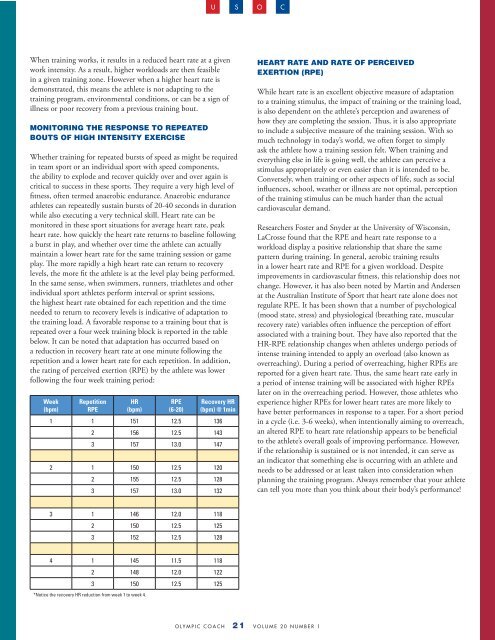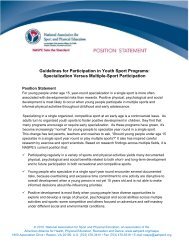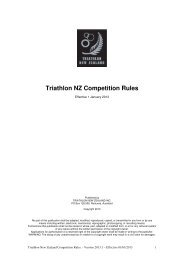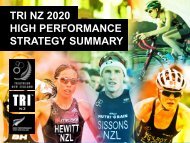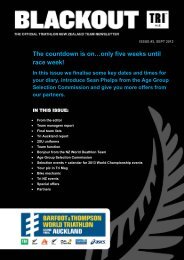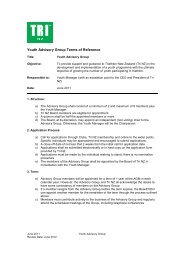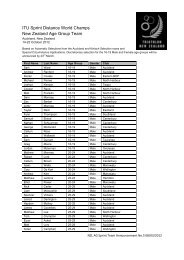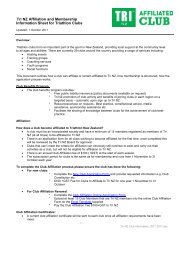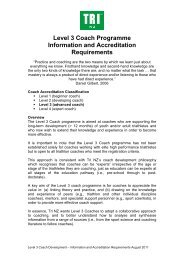Cycling Your Periodization - United States Olympic Committee
Cycling Your Periodization - United States Olympic Committee
Cycling Your Periodization - United States Olympic Committee
Create successful ePaper yourself
Turn your PDF publications into a flip-book with our unique Google optimized e-Paper software.
U S O CWhen training works, it results in a reduced heart rate at a givenwork intensity. As a result, higher workloads are then feasiblein a given training zone. However when a higher heart rate isdemonstrated, this means the athlete is not adapting to thetraining program, environmental conditions, or can be a sign ofillness or poor recovery from a previous training bout.Monitoring the Response to RepeatedBouts of High Intensity ExerciseWhether training for repeated bursts of speed as might be requiredin team sport or an individual sport with speed components,the ability to explode and recover quickly over and over again iscritical to success in these sports. They require a very high level offitness, often termed anaerobic endurance. Anaerobic enduranceathletes can repeatedly sustain bursts of 20-40 seconds in durationwhile also executing a very technical skill. Heart rate can bemonitored in these sport situations for average heart rate, peakheart rate. how quickly the heart rate returns to baseline followinga burst in play, and whether over time the athlete can actuallymaintain a lower heart rate for the same training session or gameplay. The more rapidly a high heart rate can return to recoverylevels, the more fit the athlete is at the level play being performed.In the same sense, when swimmers, runners, triathletes and otherindividual sport athletes perform interval or sprint sessions,the highest heart rate obtained for each repetition and the timeneeded to return to recovery levels is indicative of adaptation tothe training load. A favorable response to a training bout that isrepeated over a four week training block is reported in the tablebelow. It can be noted that adaptation has occurred based ona reduction in recovery heart rate at one minute following therepetition and a lower heart rate for each repetition. In addition,the rating of perceived exertion (RPE) by the athlete was lowerfollowing the four week training period:Week(bpm)RepetitionRPEHR(bpm)RPE(6-20)Recovery HR(bpm) @ 1min1 1 151 12.5 1362 156 12.5 1433 157 13.0 1472 1 150 12.5 1202 155 12.5 1283 157 13.0 132Heart Rate and Rate of PerceivedExertion (RPE)While heart rate is an excellent objective measure of adaptationto a training stimulus, the impact of training or the training load,is also dependent on the athlete’s perception and awareness ofhow they are completing the session. Thus, it is also appropriateto include a subjective measure of the training session. With somuch technology in today’s world, we often forget to simplyask the athlete how a training session felt. When training andeverything else in life is going well, the athlete can perceive astimulus appropriately or even easier than it is intended to be.Conversely, when training or other aspects of life, such as socialinfluences, school, weather or illness are not optimal, perceptionof the training stimulus can be much harder than the actualcardiovascular demand.Researchers Foster and Snyder at the University of Wisconsin,LaCrosse found that the RPE and heart rate response to aworkload display a positive relationship that share the samepattern during training. In general, aerobic training resultsin a lower heart rate and RPE for a given workload. Despiteimprovements in cardiovascular fitness, this relationship does notchange. However, it has also been noted by Martin and Andersenat the Australian Institute of Sport that heart rate alone does notregulate RPE. It has been shown that a number of psychological(mood state, stress) and physiological (breathing rate, muscularrecovery rate) variables often influence the perception of effortassociated with a training bout. They have also reported that theHR-RPE relationship changes when athletes undergo periods ofintense training intended to apply an overload (also known asoverreaching). During a period of overreaching, higher RPEs arereported for a given heart rate. Thus, the same heart rate early ina period of intense training will be associated with higher RPEslater on in the overreaching period. However, those athletes whoexperience higher RPEs for lower heart rates are more likely tohave better performances in response to a taper. For a short periodin a cycle (i.e. 3-6 weeks), when intentionally aiming to overreach,an altered RPE to heart rate relationship appears to be beneficialto the athlete’s overall goals of improving performance. However,if the relationship is sustained or is not intended, it can serve asan indicator that something else is occurring with an athlete andneeds to be addressed or at least taken into consideration whenplanning the training program. Always remember that your athletecan tell you more than you think about their body’s performance!3 1 146 12.0 1182 150 12.5 1253 152 12.5 1284 1 145 11.5 1182 148 12.0 1223 150 12.5 125*Notice the recovery HR reduction from week 1 to week 4.O L Y M P I C C O A C H 2 1 V O L U M E 2 0 N U M B E R 1


